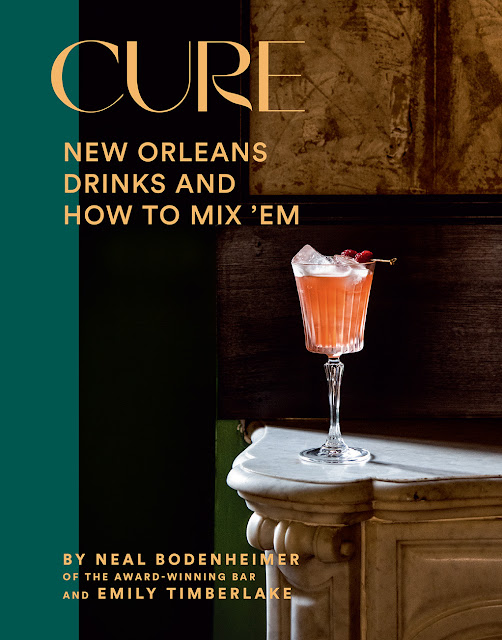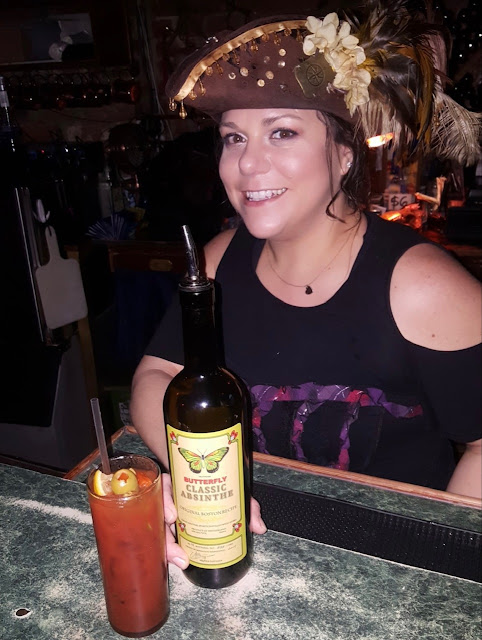A small confession. The first few paragraphs here were provided by ChatGPT.
"Absinthe and New Orleans cocktail enthusiasts, get ready to add two new books to your reading list! Marielle Songy's "The Absinthe Frappé" and Neal Bodenheimer's "Cure: New Orleans Drinks and how to mix 'em" are two must-read books for anyone interested either in the history and culture of absinthe or New Orleans cocktails more generally.
On the other hand, "Cure: New Orleans Drinks and how to mix 'em" by Neal Bodenheimer is a cocktail recipe book that celebrates the unique culture of New Orleans. While the book is not specifically focused on absinthe, it includes several absinthe-based cocktails (actually only one: the Absinthe Suissesse, alongside five with Herbsaint), as well as other classic New Orleans drinks like the Hurricane and the French 75.
What sets "Cure" apart from other cocktail books is its focus on the history and culture of New Orleans. The book includes essays and stories about the city's bartenders, drinks, and traditions, giving readers a deeper understanding of the unique cocktail culture of the Big Easy. Overall, both "The Absinthe Frappé" and "Cure: New Orleans Drinks and how to mix 'em" are excellent additions to any absinthe lover's book collection. Whether you're interested in the history of absinthe in New Orleans or just looking for some new cocktail recipes to try, these books are sure to satisfy. So, pour yourself a glass of absinthe and settle in for a good read!"
So much for ChatGPT.
What do I think of these books?
"The Absinthe Frappé" is a superb addition to the books I have reviewed previously about absinthe and cocktails. It has an excellent history of absinthe, correctly crediting the Henriods with its creation, and then detailing its boom, bust and subsequent re-birth. The book's focus is unashamedly American, mainly on New Orleans as the birthplace of the absinthe frappé. The story of the absinthe frappé is told in great detail and the book concludes with eleven absinthe cocktails and a list of bars in New Orleans where one can enjoy an absinthe frappé.
Including, of course, The Old Absinthe House.
Followed by a wonderful three page list of sources. Sadly many of these are digital links, which may require a lot of concentration to type in correctly (do not attempt to type in these links after a few absinthe frappés!). Generally typing in the keywords (e.g. a book title) may get you to the link. Google famous new orleans drinks and how to mix 'em to get to a legal digital version of this classic.
Don't be deceived by the book's size (4.8 x 0.32 x 6.85 inches). The book is very detailed, with a lot of information not assembled together elsewhere and with absolutely no padding. Its size allowed me to take it and to enjoy it on train journeys and will allow those visiting New Orleans to use it as a great guide book while going on a tour of the best absinthe bars in NOLA. It is not a coffee table book (many of those are books that are bought to be displayed and are never read). This is very definitely a book to be read, to be enjoyed and, hopefully, to inspire its readers to perfect their absinthe frappé making skills!
"The Absinthe Frappé" was written by Marielle Songy, who was born and raised in New Orleans. We've been Facebook friends for a while and I am grateful to her and her publishers for an advance copy of the book for review. When I got the book, I asked her some questions: these and her answers follow:
Do you have any plans to write more about absinthe and/or any other absinthe cocktails?
I don't have any current plans to write about any other absinthe cocktails, but I do want this to be the beginning of adding to the conversation and absinthe education. I hope to do what I can to spread the word about absinthe, dispel the myths, and hopefully make it a bit more popular again (or at least get to the point where at least one absinthe-forward cocktail is offered on fine cocktail menus).
What was the most surprising thing you discovered about absinthe and/or the Frappé?
One thing I discovered in my research is just how versatile absinthe is! Before I started the book, I hadn't really tried many absinthe-forward cocktails. The book changed that. Of course there's the Frappe, but all of the cocktails in my cocktail guide are drinks I have tried throughout this process. My favorites are Bitter Party of One and Death in the Afternoon.
How many absinthe frappés did you have to consume while researching/writing the book? Do you make this great cocktail at home or do you prefer to drink it in the great bars of NOLA?
I tried many absinthe frappes throughout my research and I was surprised at how different they are, depending on the bar! My favorite is still the classic with the crushed ice and simple syrup, but Mr. B's had an interesting one served in a martini glass with egg white in it. I was also surprised at how many bars serve the frappe "neat" with no ice. I have made the cocktail at home because it's quite easy, but I do prefer to enjoy it at a nice bar.
Would you be brave enough to specify the best absinthe frappé you had? What was so great about it? And which bar? Or would you prefer not to answer that? For me, it was at Cure and, of course, it contained La Clandestine!
My favorite is definitely Cure. I just think it's made perfectly with the dome of ice and is a feast for the eyes as well as the taste buds!
.....................
Marielle and I agree on a lot. Notably on the role of the Henriods and on the best place in NOLA to enjoy the absinthe frappé. I hope to get to NOLA again soon to enjoy this superb drink at Cure with Marielle. Santé!
When I told Marielle that her book was going to be reviewed at the same time as "Cure: New Orleans Drinks and how to mix 'em," she wrote "I am beyond flattered to be included in the same universe as Neal's wonderful book, of which I also have a copy." Here is Cure NOLA:
I first made it to Cure and met Neal Bodenheimer on July 15th, 2013, which was also my first day ever in New Orleans. I was staying at The Monteleone for Tales of the Cocktail and was just a few yards from The Old Absinthe House, so Cure was not the first NOLA bar I visited. But it made a big impression on me, so I was thrilled to be given Neal's new book as a present a few months ago.
For those of my readers who want to read about absinthe, you may be a little disappointed to note that there are not many absinthe recipes in this book. There is a recipe for Absinthe Suissesse (which has been one of my favourites recently) and, in the food recipe section,
you'll find Mussels in Absinthe. Gorgeous!
This being New Orleans, there are, of course, several recipes with Herbsaint and, since absinthe and Herbsaint are more interchangeable here than anywhere else, that's understandable.
Neal's book is, indeed, a gorgeous and highly practical cocktail book with an amazing collection of almost every classic New Orleans cocktail. The Sazerac,
the French 75, Ramos Gin Fizz. the Hurricane etc. Every New Orleans classic apart from the Absinthe Frappé. It's almost as if Neal knew Marielle's book was on the way!
It's a superb cocktail book, detailing Cure's style, spirits selection criteria, and techniques. As examples of the care and love that goes into making a Cure cocktail, there's almost a whole page about how to express citrus and another on whether or not to chill glassware!
From then on, Cure follows a straight-ish historical line through New Orleans cocktails from the Sazerac (and variations), the Old-Fashioned (and variations) etc.
The cocktails are interspersed with sections on the New Orleans Cocktail Bucket list (the best bars in town), the best music venues, classic dive bars, Black bars, Mardi Gras, and a page on the Green Fairy! This is a book to bring back memories of Tales of the Cocktail and NOLA (yes, it's time I returned post-Covid), with mentions of many people I have met there or elsewhere. This is a book with, it seems, hundreds of short stories (some of these are cocktails, some are Neal's anecdotes about NOLA). It's a book you dip into for inspiration or an idea, and half an hour later you're still reading about a cocktail's variations or the technical issues involved. For example, Cure used to use 21 drops of Peychaud's in a Sazerac but now uses 23 drops!
................................
I love both these books: Marielle's for the deep dive (thank you, ChatGPT) into the history and culture of absinthe in New Orleans, Neal's for the memories it evokes, for reminding me of the places I still have to visit in NOLA and for the amazing cocktail knowledge. This is clearly a must-have cocktail book, even if you're mainly interested in absinthe.
If you're visiting NOLA, you may find The Absinthe Frappé more portable and convenient to carry from bar to bar; alternatively you may want to splurge out on the Ebook version of Cure to take with you.
I'd recommend both! Santé, Marielle and Neal!


























































